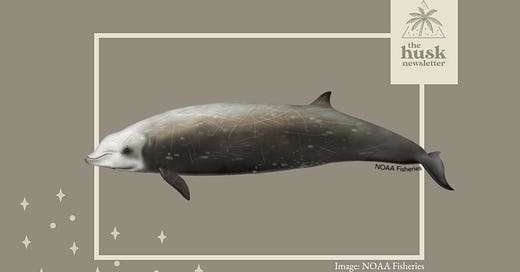This Micronesian Monday Feature is a multiple-part report about a study of beaked whales around the Marianas. 1
A few of miles off Ga’an Point in Guam, a couple of thousand feet below the surface of the ocean are a cluster of underwater acoustic sensors.
The sensors will be there for the rest of this year recording the sounds of the sea. Researchers are interested in specific sounds from a specific species: beaked whales.
They expect to use the recordings from the acoustic sensors to help them better understand the beaked whale population of the Marianas, which will also help them understand what potential impact the U.S. Navy’s sonar operation has on the beaked whales in this region, according to one researcher.

Putting acoustic sensors into the water is just the first of many steps, according to Holger Klinck, Ph.D.
Klinck is the John W. Fitzpatrick Director of the K. Lisa Yang Center for Conservation Bioacoustics at the Cornell Lab of Ornithology. He’s been the director of the Yang Center since August 2016, after joining the lab in December 2014.
Klinck in March submitted documents to Guam’s Bureau of Statistics and Plans about a project to monitor beaked whales using passive acoustics. The documents state that the acoustic recorders will be deployed about two miles from the nearest coastline and situated about 700 meters deep. He is part of a team of researchers from different parts of the world who will be working on this project.
“Our project is a first step, of many, toward estimating how large the local beaked whale population is,” Klinck told The Husk. "Beaked whales seem to be most sensitive to sonar sound exposures.”
Klinck said the U.S. Navy approached them about researching beaked whales and potential sonar impact, which is how they got involved.
Past study
The potential impact of sonar on beaked whales has been examined before.
The National Oceanic and Atmospheric Administration (NOAA) in February 2020 cited a new study NOAA conducted alongside other academic scientists that concluded that beaked whales washing up on shore in the Marianas may be associated with sonar. In the NOAA study, researchers said whales washing up on shore, also called “strandings,” have been recorded in the Marianas for 25 years.
The NOAA study noted, “no records of beaked whale strandings occurred until 2007, when a single Cuvier’s beaked whale stranded on Guam.” Since 2007, one or more Cuvier’s beaked whales have washed up on shore seven times on Guam and once on Saipan, according to NOAA. NOAA looked into these beaked whale strandings and found that out of the eight times that these types of whales have washed ashore, three of those strandings happened around the same time that naval anti-submarine sonar operations were happening.
Those three strandings happened “during or within six days after” sonar operations, according to the NOAA study.
Also in this February 2020 study, NOAA said that researchers haven’t been able to estimate the population size of Cuvier’s beaked whales in the Marianas.
Cuvier’s beaked whales
Beaked whales can stay underwater for long periods of time and prefer deep water. Plus, according to NOAA, they are barely visible when they surface.
When other whales surface and expel air from their blowholes, the characteristic puff can sometimes be seen from miles away.
Cuvier’s beaked whales rarely breach, according to NOAA. And their blowhole is small and angled slightly forward, “often making it barely visible to observers,” NOAA stated.
With these beaked whales moving stealthily on the surface, researchers will have to meet them where they are in order to find out more about them. Into the depths of the Pacific they go.
➤Next up
Why multiple parts? I started to write this and there are a lot of details that I thought were important to include. Initially, I thought I could write it up in one fell swoop but it was getting kind of long. Let me know if you think this should’ve just been one part.
Thanks for reading! Write to you again soon.







Great read. Look forward to Part 2.
- Chelsey @guams.social.progressor